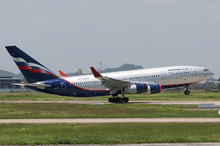Rotation (aeronautics)
In aviation, rotation refers to the action of applying back pressure to a control device, such as a yoke, side-stick or centre stick, to lift the nose wheel off the ground during the takeoff roll. Proper rotation is important for safety reasons and to decrease takeoff distance.[1] Rotation occurs when the aircraft lifts up from the runway and takes off once it reaches the optimal speed for a safe takeoff, which is called the VR speed. Certain airplanes like Boeing 727, Boeing 767, and Concorde require a high degree of rotation during takeoff, but not all airplanes require this degree of rotation. If too much rotation is added for takeoff, the airplane can face a tailstrike, or, in the worst case, will stall and crash.
Rotation is a flight concept which is integral to the design of many tricycle gear aircraft and is not applicable to conventional gear aircraft. At the design phase in tricycle gear aircraft there is a selection of the on-ground angle of attack of the wing. This angle is created in the mains and nose gear leg length design which creates a negative angle of attack relative to the ground. The effect of this is that during the takeoff roll the wing will have negative lift until the pilot commands the nose skyward to create a positive angle of attack of the wing. At the end of the flight the concept is reversed where at touchdown all tires touch the runway and the wing is instantly moved to a negative angle of attack which causes the wing to stop lifting. At one time Cessna Aircraft featured this idea as "Land O Matic," so noted on all of their tricycle-gear aircraft.
References
- ↑ Christopher L. Parker. "Normal Takeoff and Climb". AOPA. Retrieved 10 July 2010.
